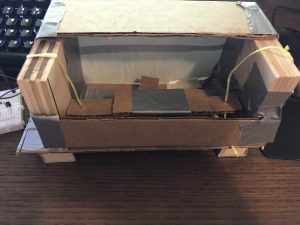Problem: Toasters currently only use their *pop* and occasionally a beep to communicate that they are finished toasting whatever is inside them. It is also difficult to tell the state of various enclosed elements of the toaster, like if the crumb tray needs to be empty, any heating elements need wiped off, etc. I believe the toaster could communicate a lot more with its “done” state in ways that would be inclusive to a variety of different user types.
Solution: More or less, a toaster that gets grumpy if it is left in a state of disrepair. Toasters are almost always associated with an energetic (and occasionally annoying) burst of energy to start mornings off, but what if the toaster’s enthusiasm was dampened? Because users are generally at least half paying attention to their toaster, a noticeably different *pop* and kinetic output could alert them that certain parts of the toaster needed attention. For example, if the toaster needed cleaned badly, it would slowly push the bread out, instead of happily popping it up. Both the visual and audio differences generated by modifying this kinetic output would be noticeable.
Proof of Concept: I constructed a model toaster (sans heating elements) using a small servo and a raising platform. Because a variety of sensing methods for crumbs did not work, “dirtiness” is represented by a potentiometer. I’ve substituted a common lever for a light push switch to accommodate a broader range of possible physical actions.


The servo drives the emotion of the toaster. It can sharply or lethargically push its contents out, providing the user its current state. Once removed, the weight of the next item to be put inside then lowers the platform back onto the servo.
Files + Video: Drive link
Discussion: This model is ripe for extension. I originally designed this around the idea of overstuffing your toaster, something I do frequently that not only doesn’t toast the bread well but surely dumps more crumbs than necessary into the bottom tray. Unfortunately, I couldn’t figure out a way to test for stuffedness, and went with straight cleanliness instead. But, the overall idea behind designing emotionally (grumpy toaster, fearful car back-up sensor) has helped me understand this class a lot better, and I hope to continue working on that line of thinking with more physical builds like this.